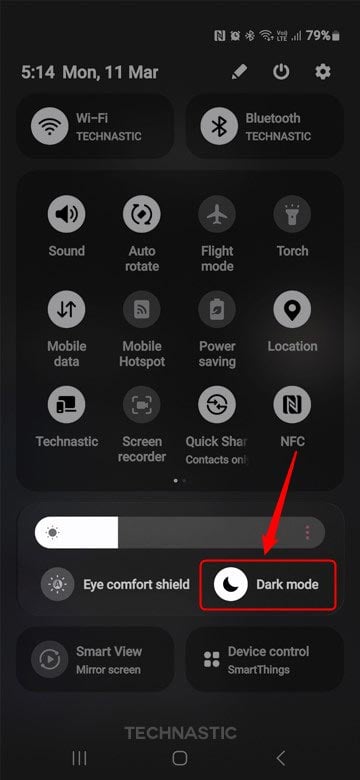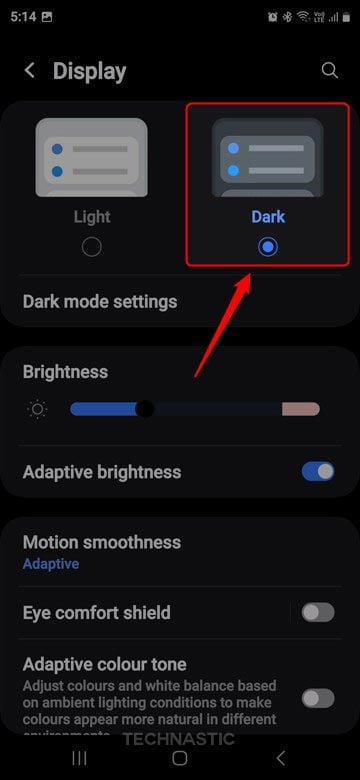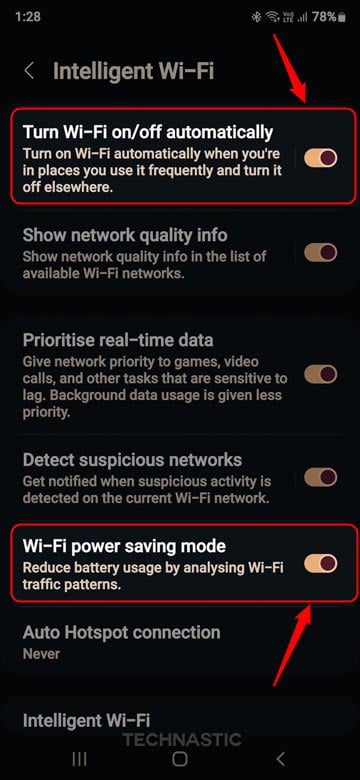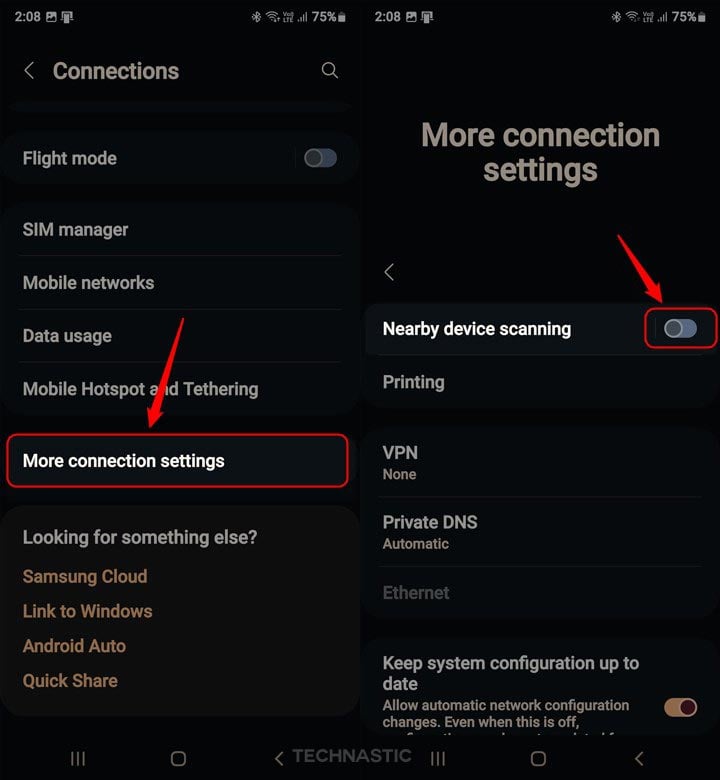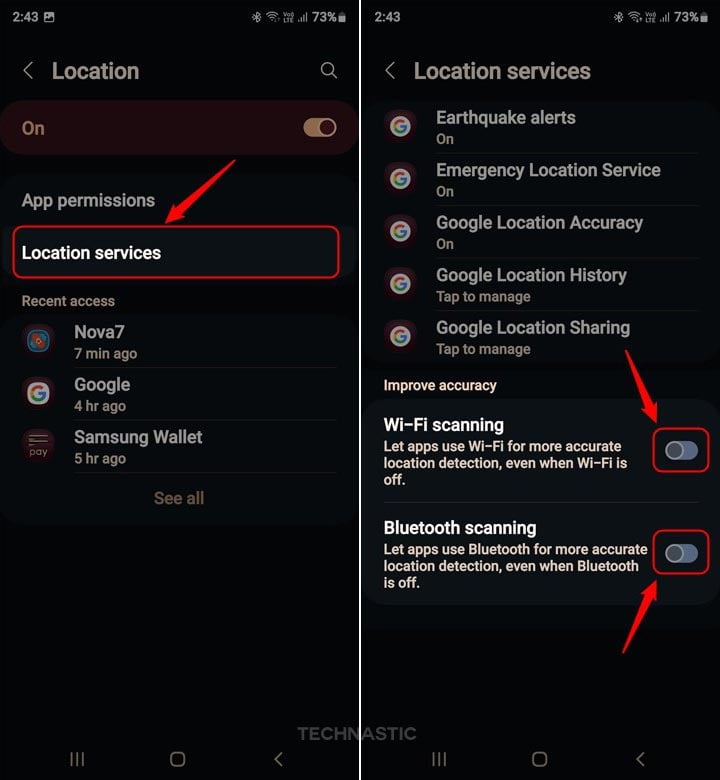- Decrease the screen resolution to Full HD
- Enable the Light performance mode
- Put less frequently apps to sleep
- Enable the power-saving mode
- Disable Wi-Fi and Bluetooth scanning
One UI 6/7 offers more efficient tweaks and settings to optimize battery usage. If your Samsung Galaxy device struggles to keep up with your daily life, we have 20 tips to maximize its battery life. From adjusting the brightness level and putting unused apps to sleep to enabling power-saving mode, we’ll cover all power-saving tips to improve the battery life on Samsung One UI 6 and 7.
Battery performance depends on usage patterns. If you spend a lot of time staring at your phone’s screen and have apps running in the background, the battery will deplete faster. Besides the tweaks mentioned in this article, you should also check out the ADB commands for battery optimization.
1. Switch to Light Performance Profile
One UI 6 and 7 allow you to choose between different processing speed modes. Follow the steps below to enable Light or Optimized performance mode on your Samsung Galaxy device.
- Open Settings, look for Device Care, and tap it.
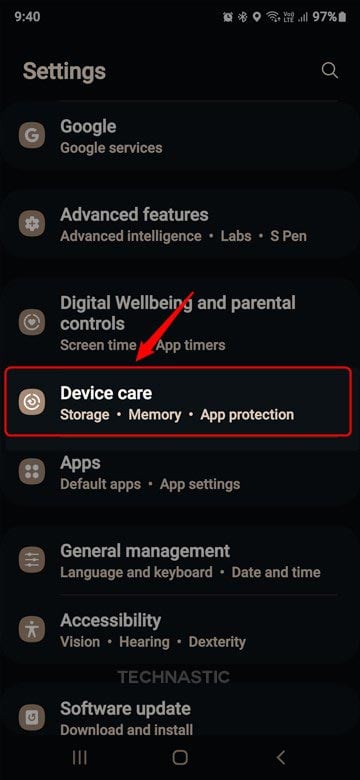
- Select Performance profile under Device Care settings on Samsung devices with One UI 6.1.
- Select Light to enable the light performance mode.
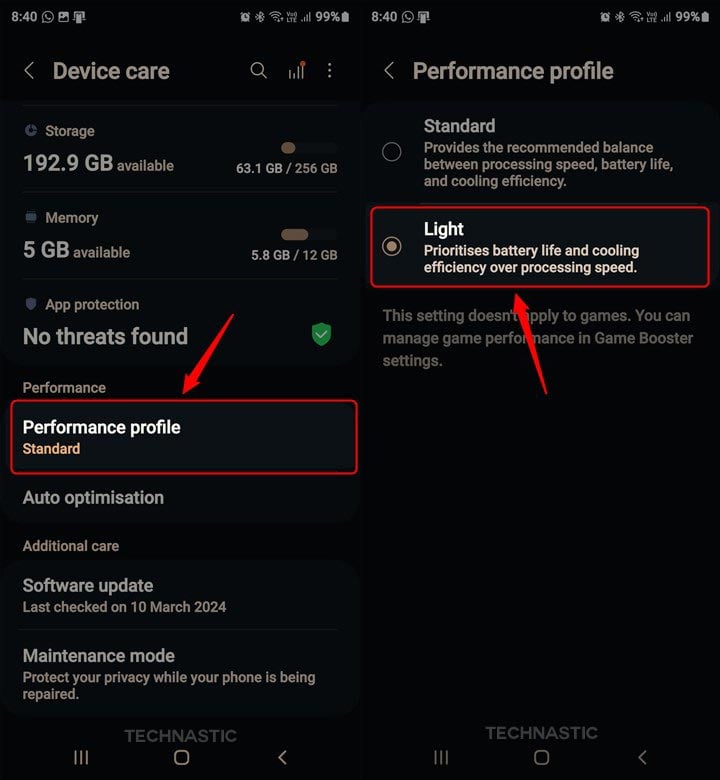
- If you own a Samsung device running One UI 6, go to Settings > Device Care > Processing speed and enable Optimized.
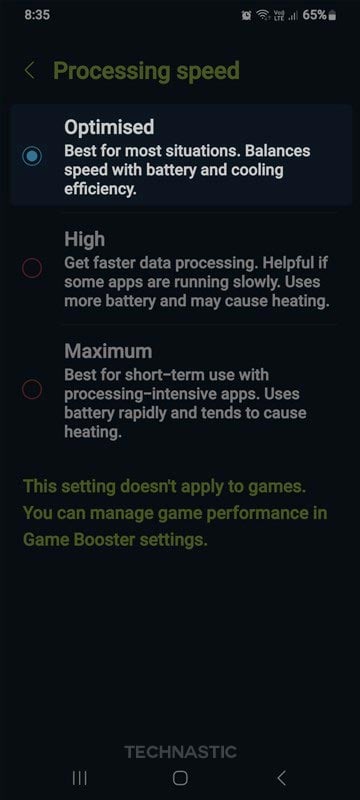
2. Reduce Display Brightness
Keeping the display brightness on the lower side can extend the battery life. A brightness level between 35% and 50% is good for your eyes and your phone’s battery.
If you spend most of the time outdoors in sunlight, you may need to set the brightness level to 75-100%. Enabling the Adaptive brightness setting on your Samsung device can save you from constantly adjusting the brightness level.
- Swipe down from the Notifications bar to open the Quick Settings panel on your device.
- Tap the 3-dot icon on the Brightness bar.
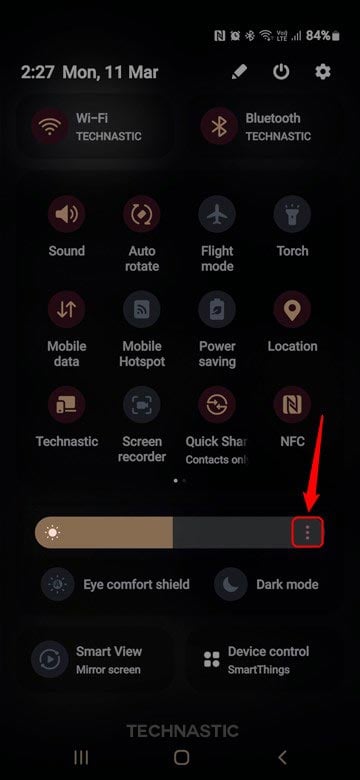
- Tap the toggle button next to Adaptive Brightness and select Done to enable it.
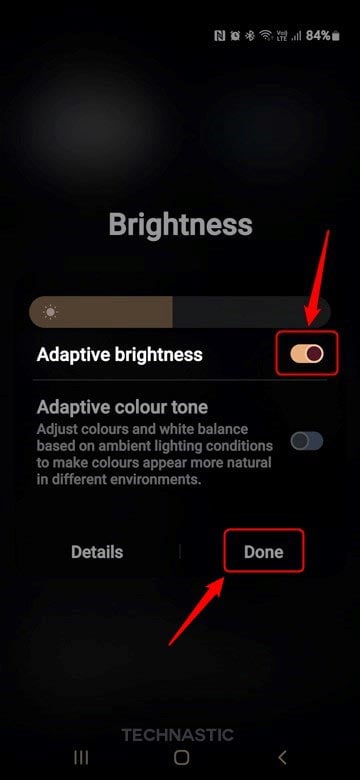
3. Set the Screen Refresh Rate to 60Hz
High-end Samsung smartphones feature up to a 120Hz refresh rate. While a higher refresh rate makes animations and screen transitions smoother, it also demands more battery and CPU. To enjoy a longer battery life on your Samsung device, you should consider lowering the screen refresh rate to 60Hz.
- Open Settings and select Display.
- Tap the Motion Smoothness option. By default, Adaptive mode (120Hz) is enabled.
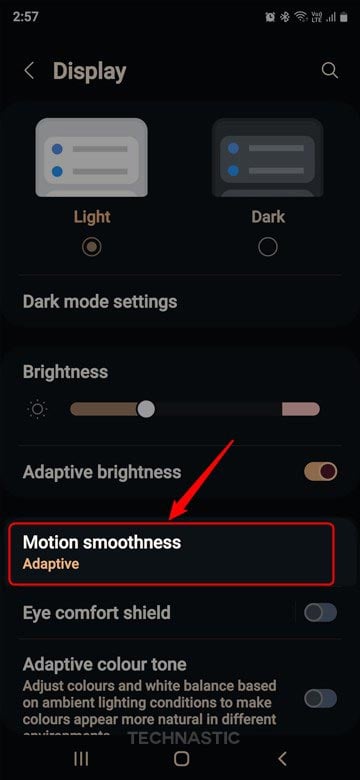
- Select the Standard mode to set the screen refresh rate to 60Hz and tap Apply.
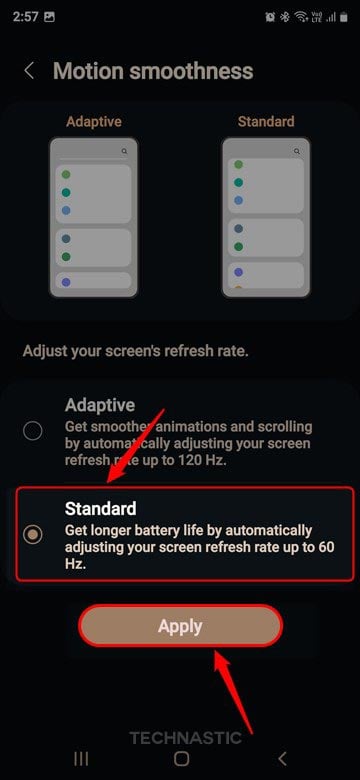
4. Switch to the Dark Mode or a Dark Theme
In dark mode, most of the dark pixels are turned on, which translates into lower battery consumption. Dark mode can save up to only 3-9% of battery power, depending on usage patterns, and save your eyes from strain.
Switching to Dark Mode on a Samsung Galaxy device is very easy. Swipe down from the Notifications bar to open the Quick Settings panel and tap the Dark Mode shortcut located below the brightness bar.
You can also switch to the Dark Mode from Settings > Display > Dark.
If you do not like the default dark theme, we have a handpicked list of the 30 best dark themes for One UI. Dark themes reduce battery usage and make your Samsung device’s UI a treat to the eyes.
5. Reduce the Screen Timeout Duration
If your phone’s screen remains on for long durations, especially when not in use, it’ll consume more battery. Moreover, it increases the chances of accidental screen touches. You can enjoy a longer battery life by setting the screen timeout to 15 or 30 seconds.
- Open Settings > Display on your Galaxy device.
- Scroll down and look for Screen timeout.
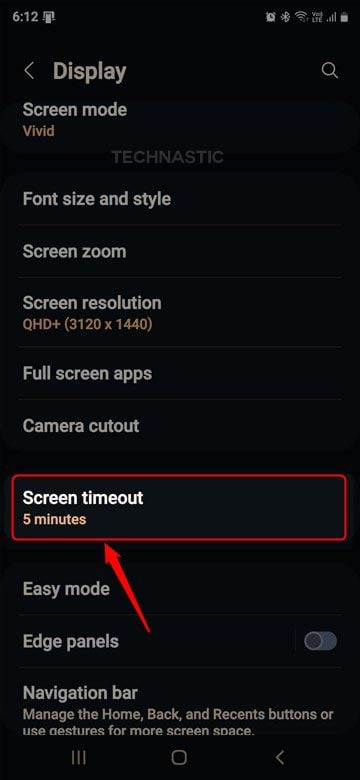
- Set the screen timeout duration to 15 seconds or 30 seconds.
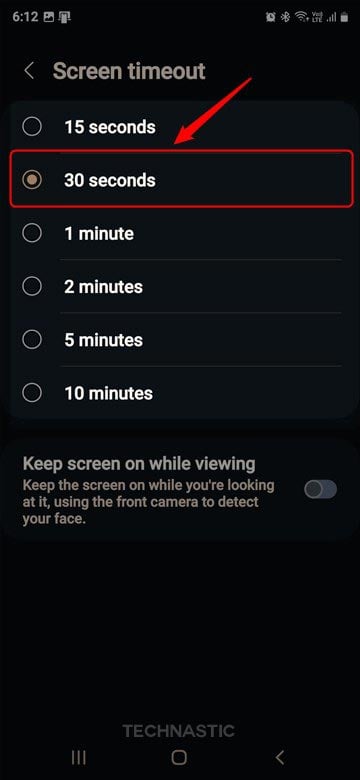
6. Decrease Screen Resolution
If you use your Samsung Galaxy device at the highest display resolution, its battery may deplete faster. All high-end Samsung phones come with QHD+ resolution. While high resolution produces sharp visuals, it also hogs battery juice. You can save battery power by switching to a lower display resolution while maintaining the visual experience.
- Open your device’s Settings.
- Tap on Display and select Screen Resolution.
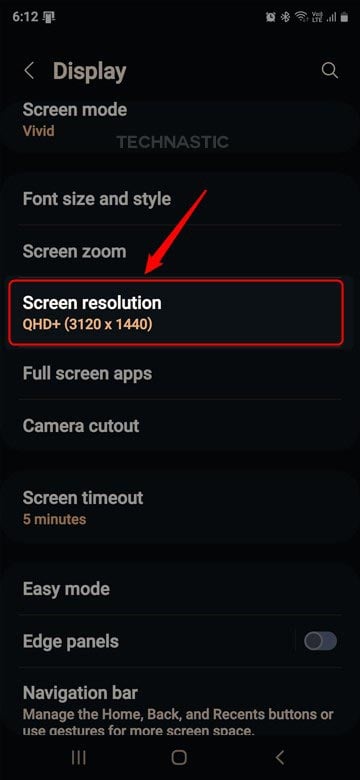
- Now select FHD+ and tap on Apply.
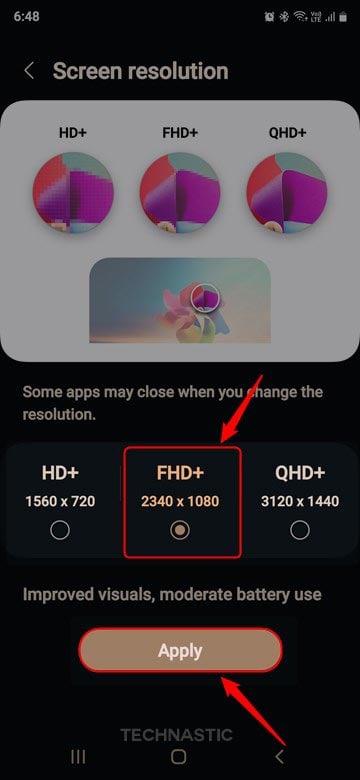
- If you have an FHD+ device, you can go down to HD+.
7. Put Unused Apps to Sleep
Upon checking the apps installed on your phone, you’ll discover many apps you use occasionally. You can stop apps from running in the background by putting them to sleep. Samsung One UI 6 settings allow you to manage unused apps and reduce battery consumption.
- Open Settings, navigate to Battery, and tap it.
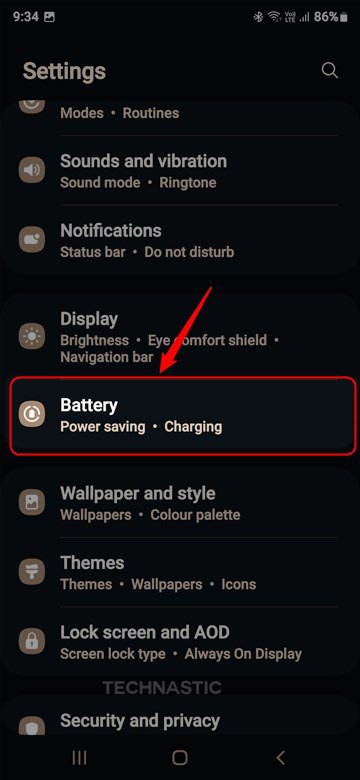
- Tap the Background usage limit option.

- Tap the toggle next to the Put unused apps to sleep option to add unused apps to the sleeping list automatically.
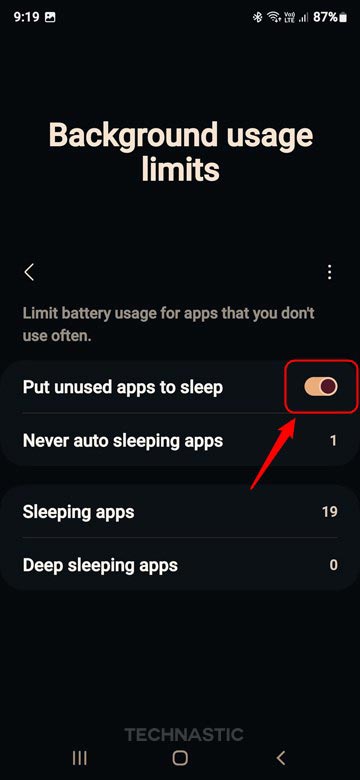
- You can also add or remove apps from the sleeping list manually. Tap the following options.
- Never auto-sleeping apps
- Sleeping apps
- Deep sleeping apps
- Then tap the ‘+‘ icon in the top-right corner of the screen, select the apps, and tap Done.
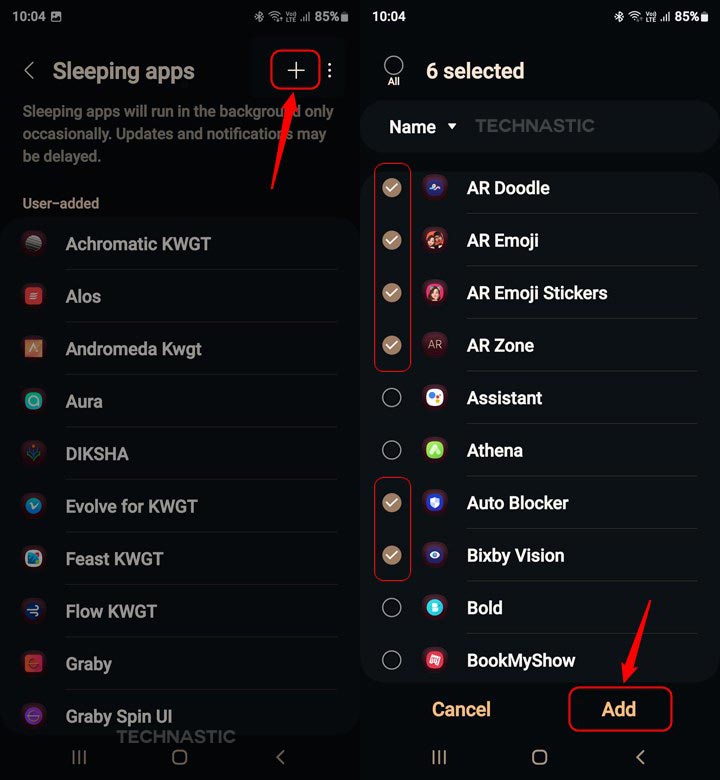
- To remove an app from the sleeping list, navigate to Sleeping Apps, tap the 3-dot icon in the top-right corner, and select Remove.
8. Turn Off the Adaptive Battery Setting
The Adaptive Battery feature automatically adapts the power consumption to usage patterns. However, I’ve noticed that this feature interferes with the power-saving settings and causes battery drain on my Galaxy S24 Ultra.
- Navigate to and open Settings > Battery > Background Usage Limits.
- Tap the 3-dot icon on the top-right corner of the screen and select Adaptive Battery.
- Tap the toggle next to On to turn it off.
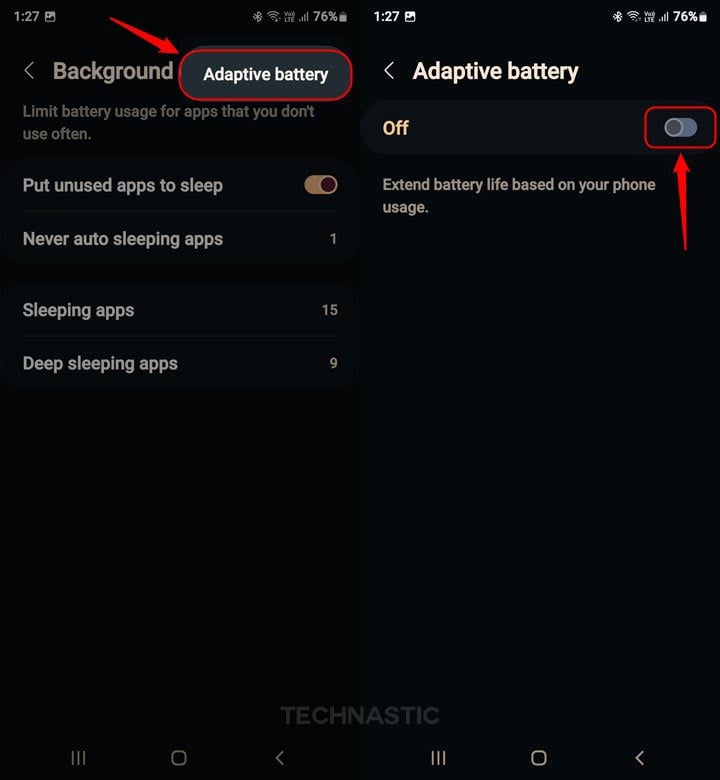
9. Debloat Your Samsung Galaxy Device
Samsung phones come with hundreds of apps preinstalled out of the box. While some are essential to the Android system, many are useless to the end user. Such apps are known as bloatware because they hog the device storage, track activity, run in the background, and cause battery drain.
You can uninstall system apps on Samsung devices via ADB, Universal Android Debloater, and ADB AppControl, and save battery and storage space. We have a carefully created Samsung bloatware list to help you.
10. Turn off Always On Display
Always On Display leverages the OLED’s capability of turning individual pixels on or off. AOD shows the date, time, and other information. Though the feature uses a small number of pixels without activating the whole display, it still consumes battery. You can either completely turn off Always On Display or at least schedule it.
- Navigate to and open Settings > Lock screen and AOD.
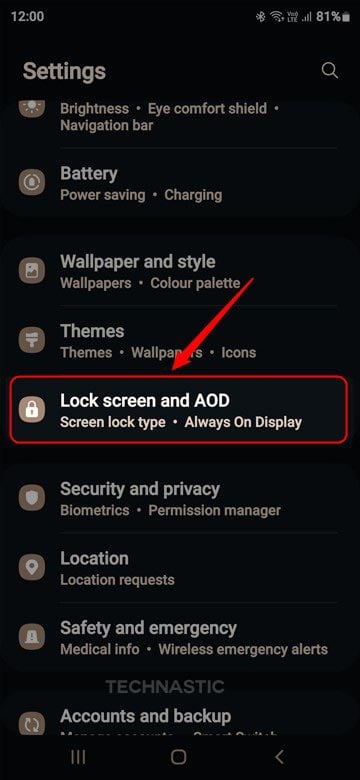
- To turn off AOD, tap the slider next to Always On Display. If you want to set a schedule, tap the option itself.
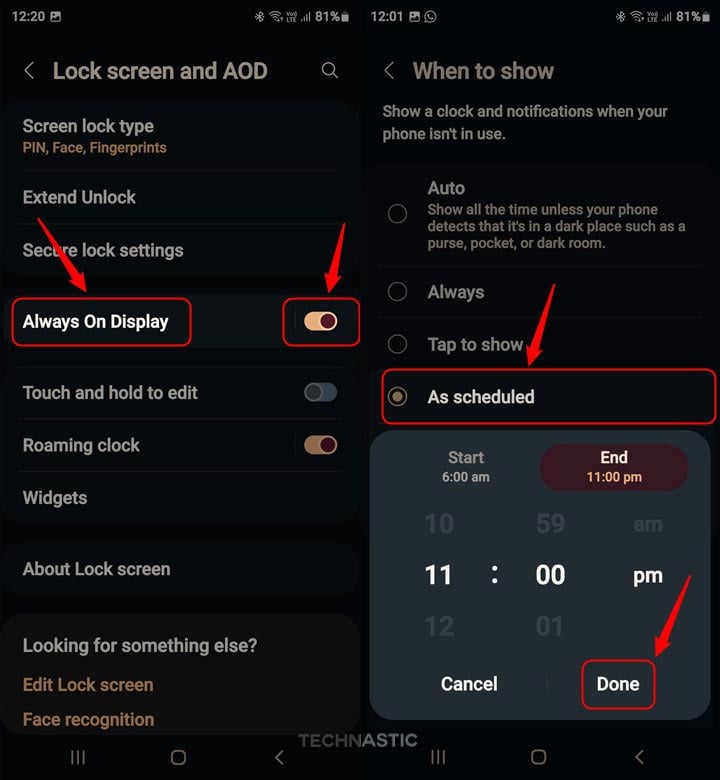
- Tap When to show > As scheduled > Set schedule and select the start and end time for AOD.
11. Use Intelligent Wi-Fi Features
When Wi-Fi is turned on, your device constantly searches for available networks, which drains the battery. Since manually toggling Wi-Fi on and off is inconvenient, you can automate the process. Samsung Galaxy devices running One UI 6 and 7 have the Intelligent Wi-Fi feature to save battery.
- Open Settings on your Samsung device.
- Tap Connections, then select Wi-Fi.
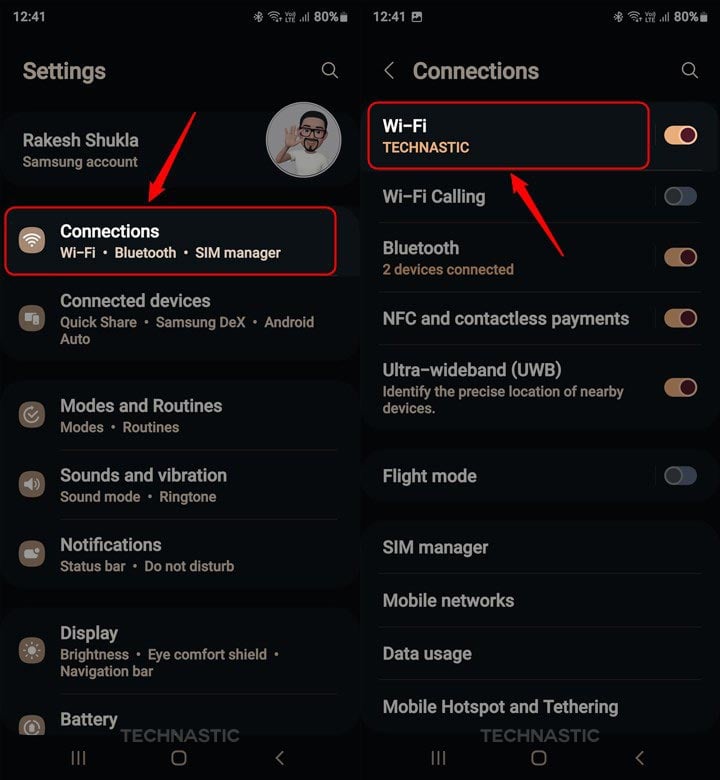
- Tap the 3-dot icon in the top-right corner of the Wi-Fi settings screen and select Intelligent Wi-Fi.
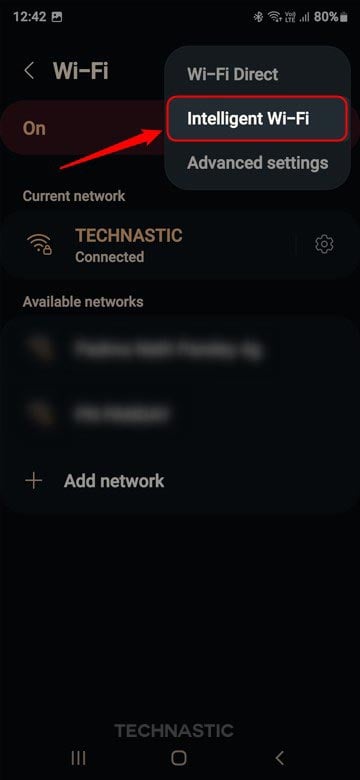
- Now, you’ll have various Intelligent Wi-Fi features at your disposal. Tap the slider next to the following options to save battery on your Samsung Galaxy device.
12. Disable Nearby Device Scanning
Device scanning is a background process that drains the battery. Turning it off can save some battery power. Go to Settings > Connections > More connection settings and turn off Nearby device scanning by tapping the toggle.
13. Turn off Wi-Fi and Bluetooth Scanning
Smartphones and computers use Wi-Fi and Bluetooth connections to get your accurate location. Keeping this feature off does more harm than good and doesn’t interfere with wireless connectivity. Navigate to Settings > Location > Location services and tap the toggles next to Wi-Fi scanning and Bluetooth scanning to turn them off.
14. Turn on Auto Optimization
The Auto Optimization feature on Samsung devices is designed to tweak the overall performance, speed, and battery life. You can enable this feature to clean junk files and background processes for improved battery performance.
- Navigate to and open Settings > Device Care on your Samsung phone.
- Tap the Optimize Now button.
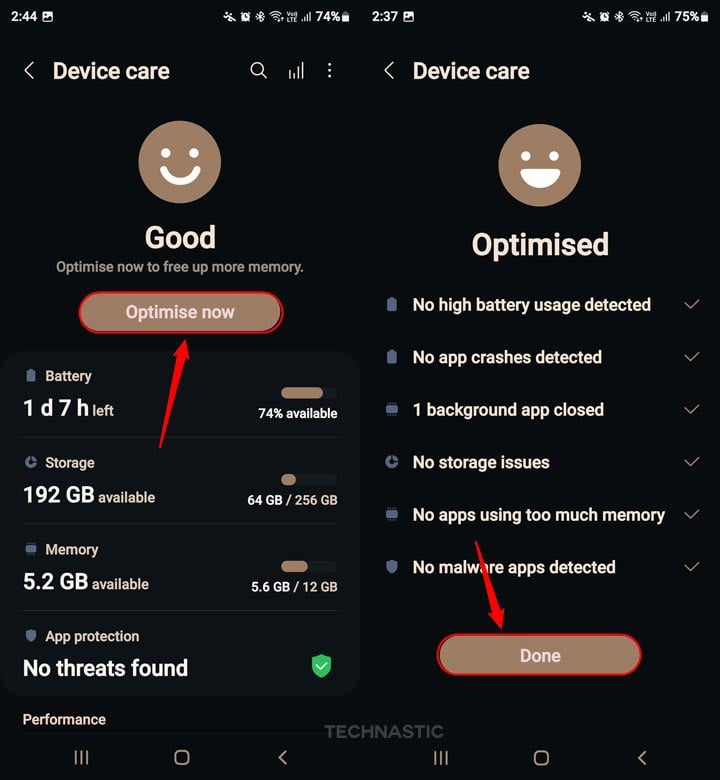
- To automate this process for periodic checks, tap Auto Optimization > Auto Restart.
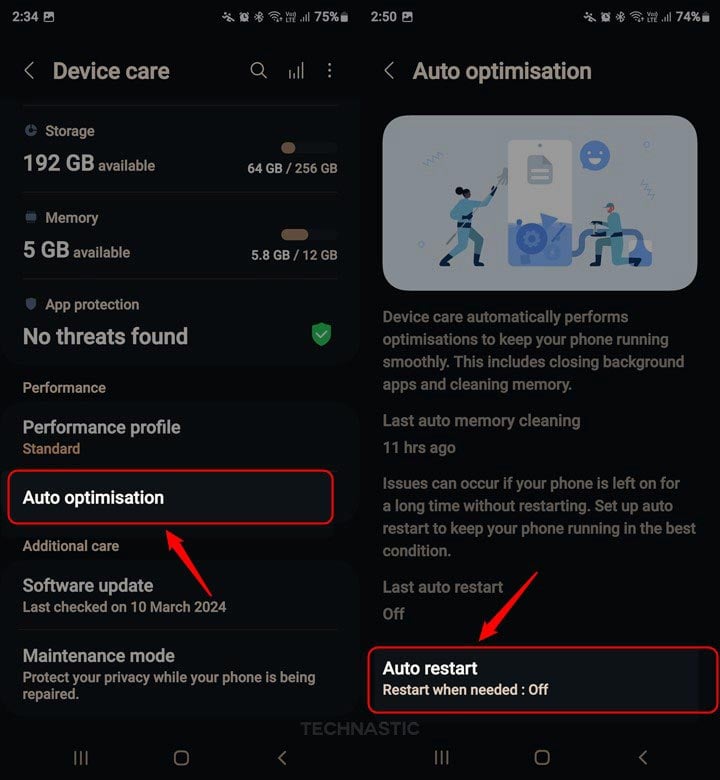
- Next, tap the toggle next to Restart on schedule and set the time and days of the week.
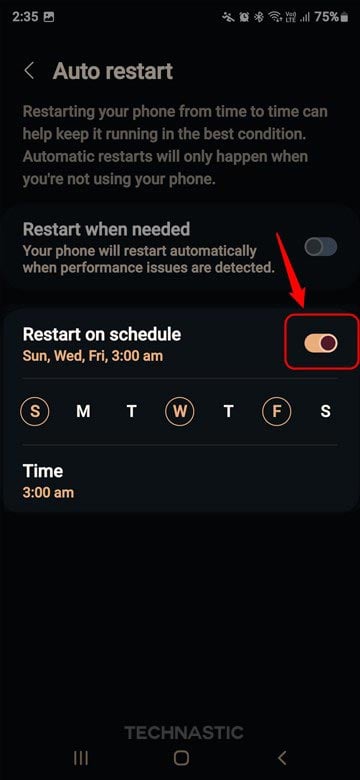
15. Enable Power Saving Mode
The Power Saving mode disables background location checking, data syncing, UI animations, 120Hz screen refresh rate, AOD, 5G, etc. Moreover, it decreases CPU speed to 70% and display brightness by 10%. It extends the battery life, but at the same time, it may impact the user experience. Therefore, it’s a good idea to customize the power-saving mode before enabling it.
- Navigate to and open Settings > Battery > Power saving.
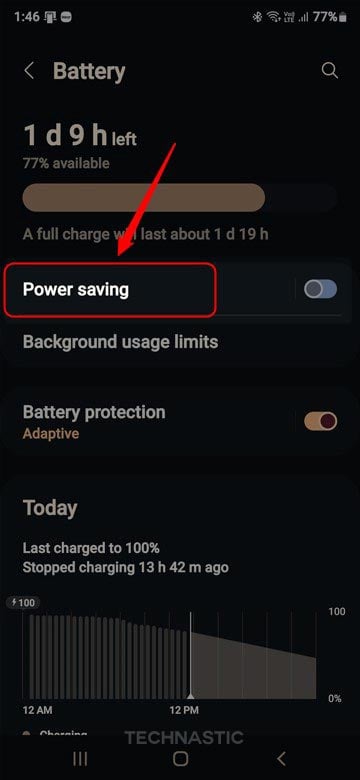
- Before enabling the Power Saving mode, do the following.
- Turn off Always On Display: ON
- Limit CPU speed to 70%: ON
- Decrease brightness by 10: ON
- Turn off 5G: OFF
- Limit app and Home screen: OFF
- Having done the tweaks, tap the toggle next to the Power Saving option to enable it.
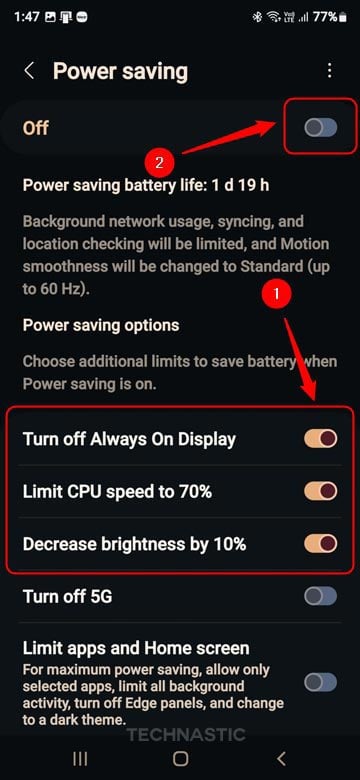
- If you are curious, below is a comparison of battery life before and after enabling the Power Saving mode after customization.
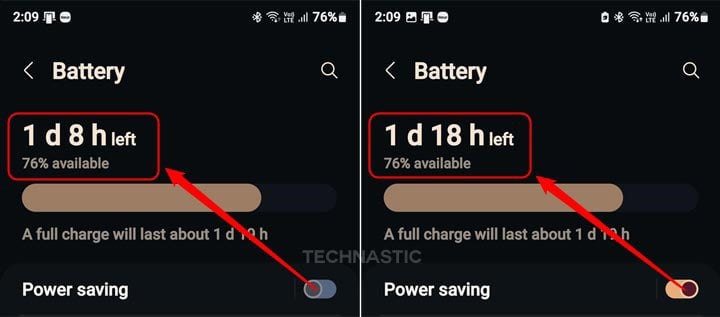
16. Use Modes and Routines
On Samsung devices with One UI 6 and 7, you can decide how your phone behaves while at home, sleeping, driving, exercising, at the workplace, etc. Once you configure what setting you want to override or what setting you want to add when specific conditions are met, your device will automate things for you. For example, you can set custom volume levels, notifications, power-saving modes, display brightness, AOD, and restrict apps for different modes.
The Modes and Routines feature can help you stay focused, avoid distractions, and save battery.
- Open Settings and tap Modes and Routines.
- Select a Mode from the list or tap Add mode to create a custom mode.
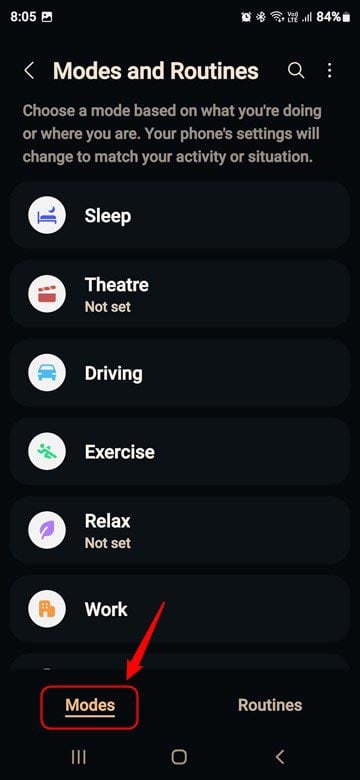
- Tap Start and set your preferences for the mode.
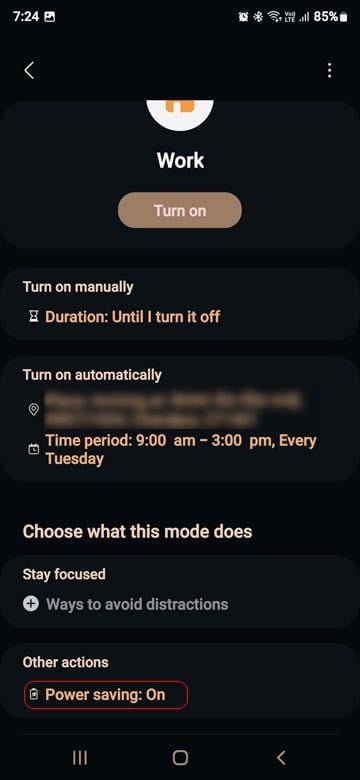
- Having configured your preferred modes, tap Routines and then the ‘+‘ icon to create a routine.
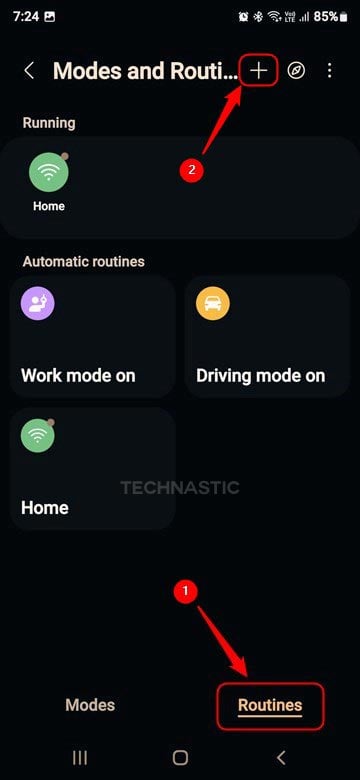
- Now, set up the conditions to trigger a specific action and Save the routine.
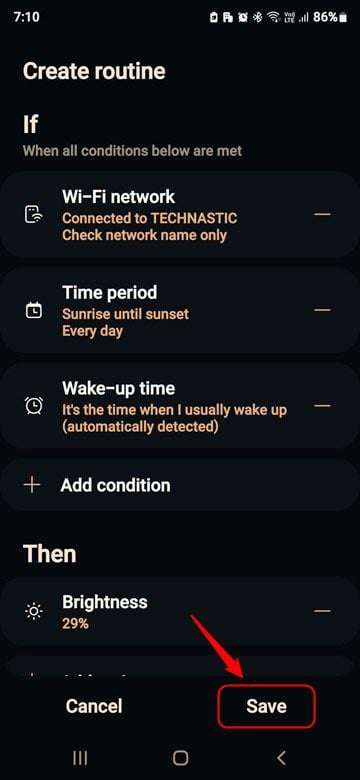
Your Samsung device will automatically switch to different modes and stimulate custom settings according to your setup.
17. Change Your Charging Habits
The following battery charging tips will help you ensure that your Samsung phone’s battery charges efficiently and its lifespan is longer. You can check the battery’s health, its charge cycle count, and current capacity using ADB.
- Do not let your phone’s battery drain below 20% and charge it over 80 or 85%. You can enable the Battery Protection feature from Settings > Battery.
- Disable wireless charging, as it doesn’t charge the device efficiently and causes overheating, which is bad for the battery’s health.
- Fast-charge your device only when necessary. Slow charging at 5~10W (5V 1A, 5V 2A) is good for a longer battery lifespan. Remember, slow but steady wins the race. Go to Settings > Battery > Charging settings and disable Fast charging.
18. Disable Sending Diagnostic Data
Android devices send diagnostic, device, and app usage data to Google and their respective manufacturers. The option is enabled by default and uses mobile data and battery juice.
- Go to Settings > Security and Privacy.
- Look for More privacy settings and tap it.
- On the next screen, tap the toggle next to the Send diagnostic data option to disable it. Your Galaxy device will no longer send data to Samsung.

- Now, tap the Usage and Diagnostic option located at the bottom of the same screen and disable it.
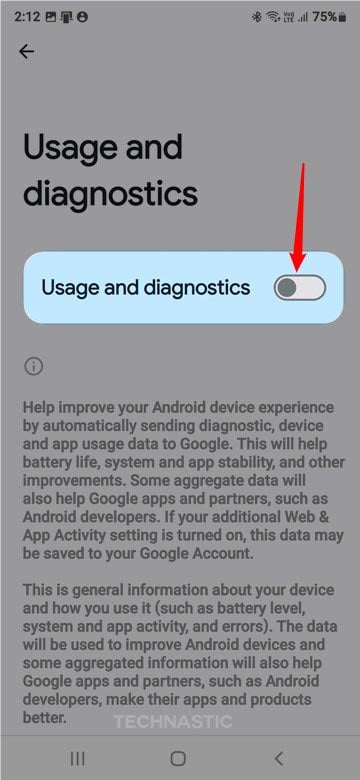
19. Disable Background Data Usage
While apps related to calling, social media, email, messaging, maps, etc., use data in the background to function properly, we can safely disable background data usage for others. Doing so will save data and battery.
- Open Settings on your Samsung phone and go to Connections > Data Usage > Mobile Data Usage.
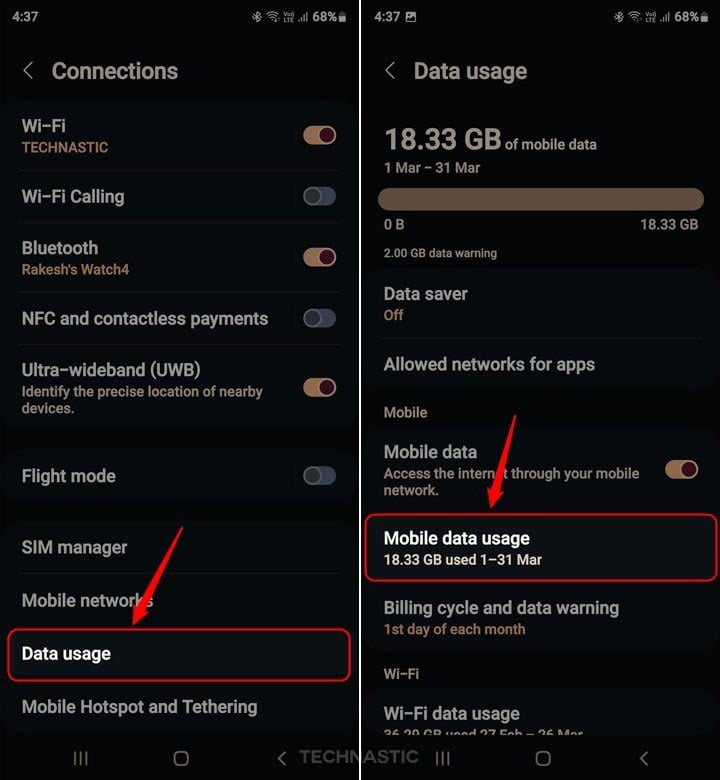
- Now tap the app you want to restrict from using data when not in use and turn off the toggle next to Allow Background Data Usage.
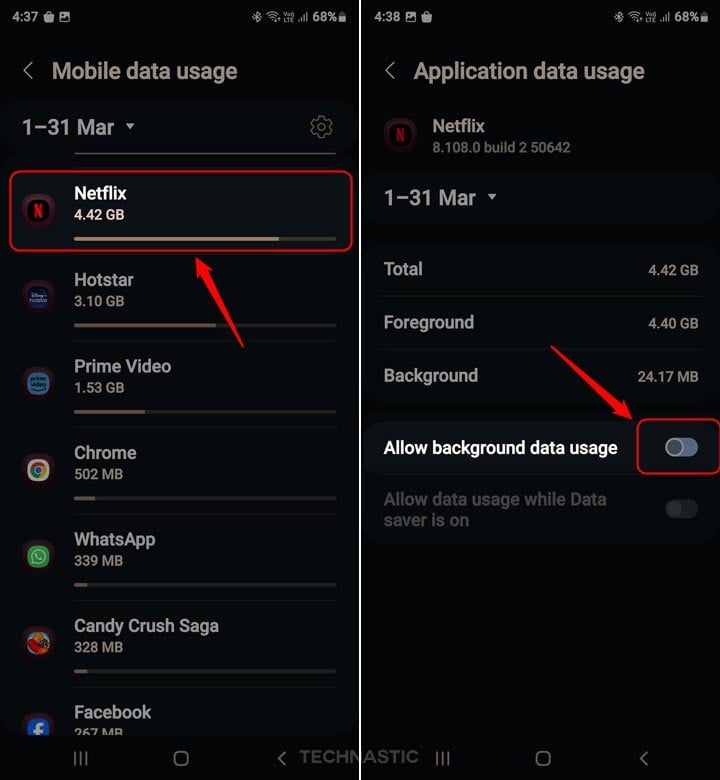
20. Enable Process Data only on This Device
Samsung introduced more than 16 Galaxy AI features with One UI 7. While some AI or Advanced Intelligence features use device resources, many others process data online. By disabling online data processing, you can enhance your privacy and save battery on Samsung Galaxy devices.
- Open Settings and navigate to Advanced Features > Advanced Intelligence.
- Look for the Process Data only on Device option and tap the slider button to turn it on.
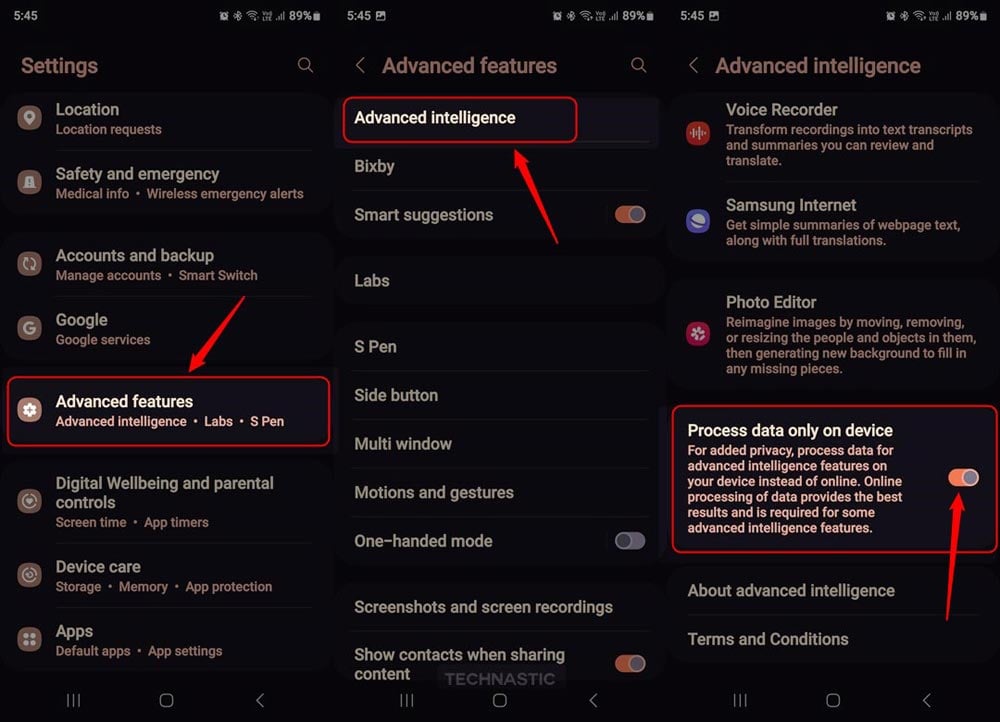
21. Keep Your Phone Cool
Lithium-ion (Li-ion) batteries drain faster in hot weather due to several heat-related effects on their chemistry and internal components. Heat stresses the battery chemically and electronically. It leads to a faster self-discharge rate and potential long-term damage. To prevent your phone’s battery from draining even when not in use, try these tips to fix the device’s overheating problem.
22. Clean System Cache
Cleaning the app and system cache on Android addresses several issues, including battery drain. Boot into Recovery Mode on your Samsung phone and wipe the cache partition. You’ll surely notice a boost in battery performance after clearing the cache.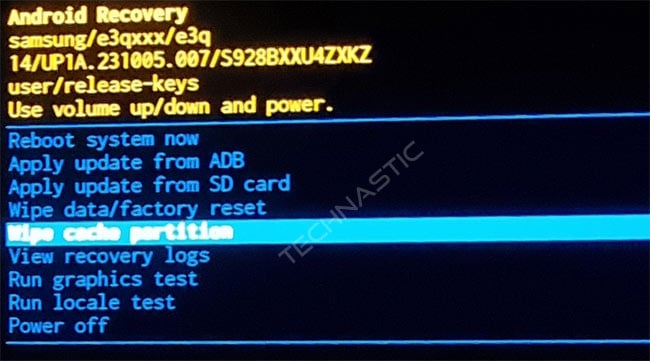
Most of the battery-saving tips mentioned in this article suggest disabling features that users spend money on. Sadly, we have to limit the capability of even a flagship phone like the Galaxy S4 Ultra to enjoy a longer battery life. The above battery-saving tips for Samsung devices will extend battery life without hampering your experience.
Read Next: One UI 7 Optimization Tips and Tricks
